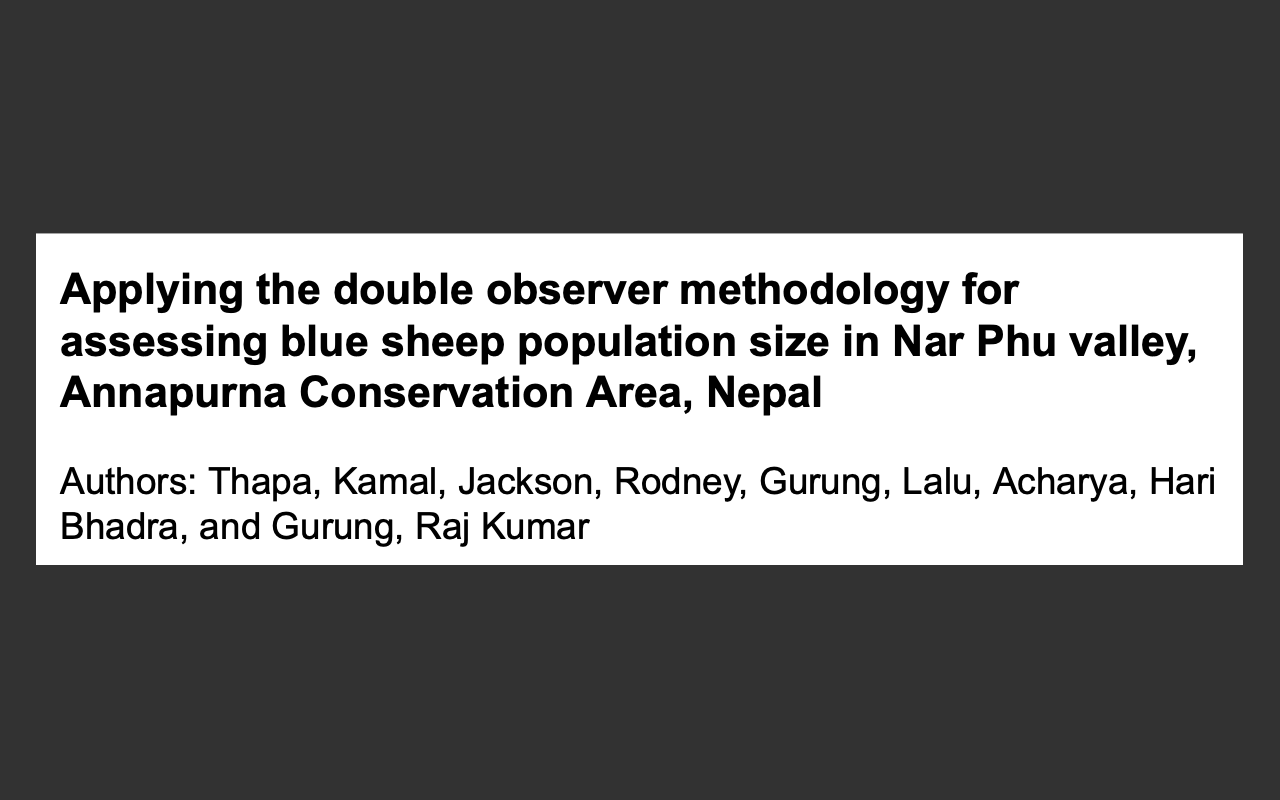Please find details below of new articles added to our Bibliography:

Title: Modelling Potential Distribution of Snow Leopards in Pamir,
Northern Pakistan: Implications for Human–Snow Leopard Conflicts
Author: Rashid, W., Shi, J., Rahim, I. U., Qasim, M., Baloch, M. N.,
Bohnett, E., Yang, F., Khan, I., Ahmad, B.
Abstract: The snow leopard (Panthera uncia) is a cryptic and rare big
cat inhabiting Asia’s remote and harsh elevated areas. Its population
has decreased across the globe for various reasons, includ ing
human–snow leopard conflicts (HSCs). Understanding the snow leopard’s
distribution range and habitat interactions with human/livestock is
essential for understanding the ecological context in which HSCs occur
and thus gives insights into how to mitigate HSCs. In this study, a
MaxEnt model predicted the snow leopard’s potential distribution and
analyzed the land use/cover to de termine the habitat interactions of
snow leopards with human/livestock in Karakoram–Pamir, northern
Pakistan. The results indicated an excellent model performance for
predicting the species’ potential distribution. The variables with
higher contributions to the model were the mean diurnal temperature
range (51.7%), annual temperature range (18.5%), aspect (14.2%), and
land cover (6.9%). Th
e model predicted approximately 10% of the study area as a highly
suitable habitat for snow leopards. Appropriate areas included those at
an altitude ranging from 2721 to 4825 m, with a mean elevation of 3796.9
± 432 m, overlapping between suitable snow leopard habitats and human
presence. The human encroachment (human settlements and agriculture) in
suitable snow leopard habitat increased by 115% between 2008 and 2018.
Increasing encroachment and a clear overlap between snow leopard
suitable habitat and human activities, signs of growing competition
between wildlife and human/livestock for limited rangeland resources,
may have contributed to increasing HSCs. A sound land use plan is needed
to minimize overlaps between suitable snow leopard habitat and human
presence to mitigate HSCs in the long run.
URL: https://snowleopardnetwork.org

Title: No silver bullet? Snow leopard prey selection in Mt.
Kangchenjunga, Nepal
Author: Thapa, K., Schmitt, N., Pradhan, N. M. B., Acharya, H. R.,
Rayamajhi, S.
Abstract: In this study, we investigated the impact of domestic and wild
prey availability on snow leopard prey preference in the Kangchenjunga
Conservation Area of eastern Nepal-a region where small domestic
livestock are absent and small wild ungulate prey are present. We took a
comprehensive approach that combined fecal genetic sampling, macro- and
microscopic analyses of snow leopard diets, and direct observation of
blue sheep and livestock in the KCA. Out of the collected 88 putative
snow leopard scat samples from 140 transects (290km) in 27 (4x4km2)
sampling grid cells, 73 (83%) were confirmed to be from snow leopard.
The genetic analysis accounted for 19 individual snow leopards (10 males
and 9 females), with a mean population size estimate of 24 (95% CI:
19-29) and an average density of 3.9 snow leopards/100km2 within 609km2.
The total available prey biomass of blue sheep and yak was estimated at
355,236 kg (505 kg yak/km2 and 78kg blue sheep/km2). From the available
prey
biomass, we estimated snow leopards consumed 7% annually, which
comprised wild prey (49%), domestic livestock (45%). and 6% unidentified
items. the estimated 47,736 kg blue sheep biomass gives a snow
leopard-to-blue sheep ratio of 1:59 on a weight basis. The high
preference of snow leopard to domestic livestock appears to be
influenced by a much smaller available biomass of wild prey then in
other regions of Nepal (e.g., 78kg/km2 in the KCA compared with a range
of 200-300 kg/km2 in other regions of Nepal?. Along with livestock
insurance scheme improvement, there needs to be a focus on improved
livestock guarding, predator-proof corrals as well as engaging and
educating local people to be citizen scientists on the importance of
snow leopard conservation, involving them in long-term monitoring
programs and promotion of ecotourism.
URL: https://snowleopardnetwork.org

Title: Applying the double observer methodology for assessing blue sheep
population size in Nar Phu valley, Annapurna Conservation Area, Nepal
Author: Thapa, K., Jackson, R., Gurung, L, Acharya, H. B., Gurung, R.
K.,
Abstract: This study was undertaken in spring, 2019 to assess the
applicability of the double-observer survey method for estimating blue
sheep Pseudois nayaur abundance in Nar-Phu valley of Manang District
located in Annapurna Conservation Area of northern Nepal. Since counting
large mammals in rugged mountain habitat poses a special challenge, we
tested the efficacy of the double observer method for generating robust
population estimates for this important protected area. The overall
detection probability for observers (O1 and O2) was 0.94 and 0.91 for a
total of 106 groups comprised of 2059 individual blue sheep. We
estimated the area’s blue sheep population at 2070 (SE ± 168.77; 95% CI
2059–2405) for the 246.2 km2 of sampled habitat. We determined blue
sheep to be widely distributed within the study area with a mean density
of 8.4 individuals per km2 based on a total study area of 246.2 km2. We
discuss demographic population structure and identify limitations when
applying
the double observer approach, along with recommending viewshed mapping
for ensuring more robust density estimates of mountain-dwelling
ungulates like blue sheep or ibex that inhabit extremely heterogeneous
terrain which strongly influences sighting distances and overall animal
detection rates.
